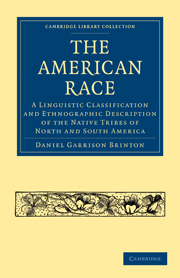 The American Race
The American Race I - THE SOUTH PACIFIC GROUP
Published online by Cambridge University Press: 29 August 2010
Summary
THE COLUMBIAN REGION
THIS region includes the mountainous district in northwestern South America, west of the basin of the Orinoco and north of the equator—but without rigid adherence to these lines. The character of its culture differed considerably from that found in the Atlantic regions and was much more closely assimilated to that of Peru. Three lofty mountain chains traverse New Granada from north to south, the intervening valleys being beds of powerful rivers, rich in fish and with fertile banks. This configuration of the soil has exerted a profound influence on the life and migrations of the native inhabitants, severing them from the fellow-members of their, race to the east and directing their rovings in a north and south direction.
The productive valleys were no doubt densely populated; though we must regard as a wild extravagance the estimate of a modern writer that at the conquest the native inhabitants of New Granada reached “six to eight millions”; and I hope that the historian Herrera was far beyond the truth when he asserted that in Popayan alone, in a single year fifty thousand of the Indians died of starvation, five thousand were killed and eaten by the famishing multitude, and a hundred thousand perished from pestilence!
Tribes of the Isthmus and Adjacent Coast
At the discovery, the Isthmus of Panama was in the possession of the Cunas tribe, as they call themselves. They are the same to whom were applied later the names Darien Indians (Wafer), Tules, Cunacunas, Cuevas, Coybas, Mandingas, Bayanos, Irriacos, San Bias Indians, Chucunacos, Tucutis, etc.
- Type
- Chapter
- Information
- The American RaceA Linguistic Classification and Ethnographic Description of the Native Tribes of North and South America, pp. 172 - 228Publisher: Cambridge University PressPrint publication year: 2009First published in: 1891
